
Omaha Beach was one of five beach landing sectors of the amphibious assault component of Operation Overlord during the Second World War.

The United States Army Rangers are U.S. Army personnel who have served in any unit which has held the official designation of "Ranger". The term is commonly used to include graduates of the Ranger School, even if they have never served in a "Ranger" unit; the vast majority of Ranger school graduates never serve in Ranger units and are considered "Ranger qualified".

The 75th Ranger Regiment, also known as the Army Rangers, is the premier light infantry unit of the United States Army. The 75th is also part of the United States Army Special Operations Command and the Department of Defense Joint Special Operations Command. The regiment is headquartered at Fort Moore, Georgia and is composed of a regimental headquarters company, a military intelligence battalion, a special troops battalion, and three Ranger battalions.
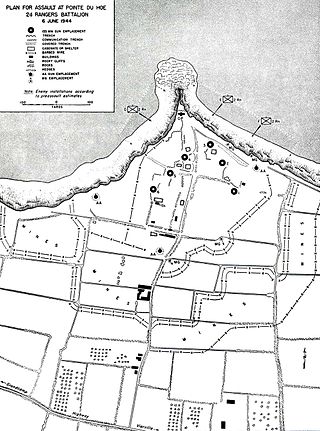
La Pointe du Hoc is a promontory with a 35-metre (110 ft) cliff overlooking the English Channel on the northwestern coast of Normandy in the Calvados department, France.

The 29th Infantry Division, also known as the "Blue and Gray Division", is an infantry division of the United States Army based at Fort Belvoir in Fairfax County, Virginia. The division is currently a formation of the Army National Guard and includes units from Virginia, Maryland, Kentucky, North Carolina, South Carolina, and West Virginia.

The 41st Infantry Division was an infantry division of the United States Army National Guard composed primarily of units from the Pacific Northwest. The division saw active service in World War I and World War II, receiving the nickname “Jungleers” during the latter.
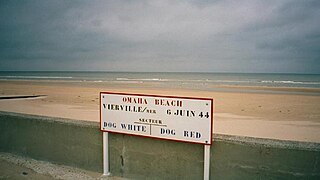
Vierville-sur-Mer is a commune in the Calvados department in Normandy region in northwestern France.
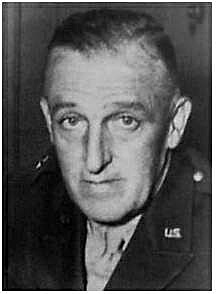
Norman Daniel "Dutch" Cota, Sr. was a senior United States Army officer who fought during World War II. Cota was heavily involved in the planning and execution of the Allied invasion of Normandy, in June 1944, codenamed Operation Neptune, and the subsequent Battle of Normandy. He is known for rallying demoralized troops on Omaha Beach on D-Day, by engaging in combat beside them and personally leading their first successful breakout, for which he was awarded the Distinguished Service Cross (DSC).

The 9th Infantry Regiment ("Manchu") is a parent infantry regiment of the United States Army.

The 2nd Ranger Battalion, currently based at Joint Base Lewis–McChord south of Seattle, Washington, United States, is the second of three ranger battalions belonging to the United States Army's 75th Ranger Regiment.

Grenadier Regiment 916 was an infantry regiment of the Wehrmacht from 1943 until 1945.
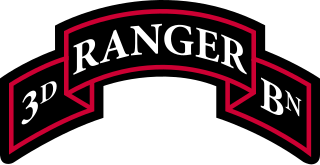
The 3rd Ranger Battalion is the third of three Ranger Battalions belonging to the United States Army's 75th Ranger Regiment. It is currently based at Fort Moore, Georgia.
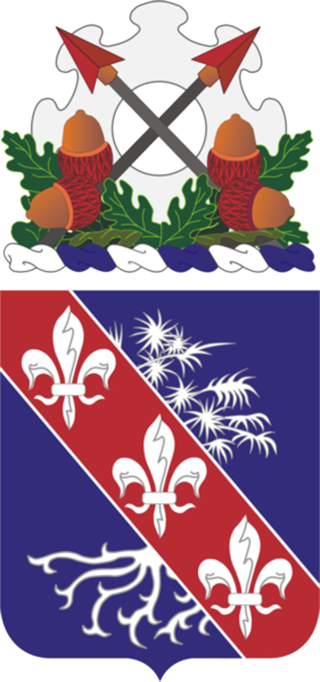
The 327th Infantry Regiment is an infantry regiment of the 101st Airborne Division of the United States Army. During World War II, the 327th was a glider-borne regiment of the 101st Airborne Division. It fought during World War I as part of the 82nd Division. It has also been deployed in the Vietnam War, Gulf War, and most recently to Iraq and Afghanistan. The song "Glider Rider" describes (humorously) some of the slights that glider-borne troops felt they received from the Army during World War II; though the regiment's public fame rose with the 1949 movie Battleground about the Siege of Bastogne in late 1944.
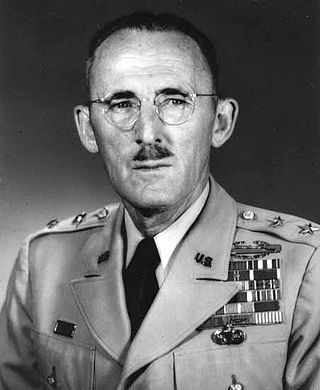
Major General Charles Draper William Canham was the commander of the 29th Infantry Division's 116th Infantry Regiment, which landed on Omaha Beach in Normandy, France, on D-Day, June 6, 1944.
The 111th Field Artillery is currently constituted as a composite battalion consisting of two batteries of 105MM towed artillery and one battery of 155MM towed artillery (M777) unit with a general support/reinforcing mission. It is a unit within the Virginia Army National Guard based in Norfolk, Virginia.

The 16th Infantry Regiment is a regiment in the United States Army and has traditionally been a part of the 1st Infantry Division.

The Hertfordshire Regiment was a line infantry regiment of the Territorial Army, part of the British Army. Originating in units of Rifle Volunteers formed in 1859, the regiment served in the Second Anglo-Boer War and the First and Second World Wars before losing its separate identity in 1961. Its lineage is continued today by the Royal Anglian Regiment.
The Provisional Ranger Group was a provisional regiment of U.S. Army Rangers that was formed for the D-Day landings in Normandy, France, in World War II.

The 116th Infantry Regiment is an infantry regiment in the Virginia Army National Guard.

Charles Thompson Horner Jr. was a highly decorated officer of the United States Army who served in the 16th Infantry Regiment, U.S. 1st Infantry Division from July 1940 to February 1946 and held every position from Platoon Leader to Regimental Commander. As a leader in the "Big Red One", he participated in the North Africa, Sicily, and the European Campaigns and three amphibious landings; the invasions of North Africa, Sicily, and Europe where he commanded the 3rd Battalion, 16th Infantry on Omaha Beach.



















